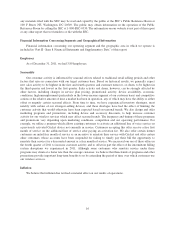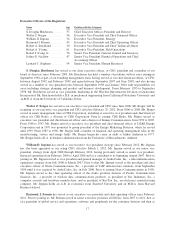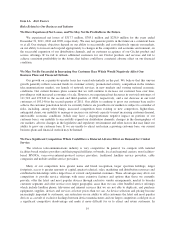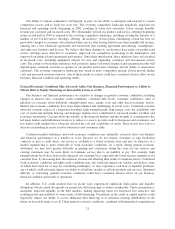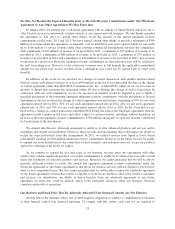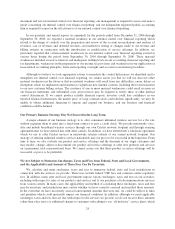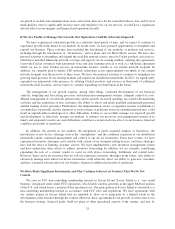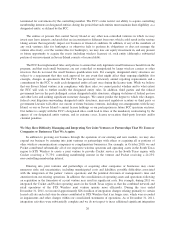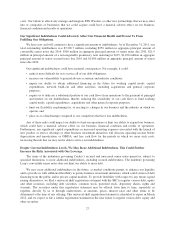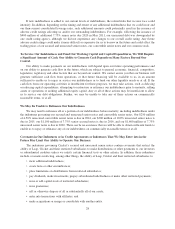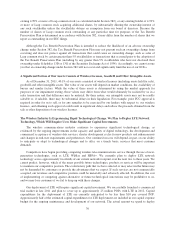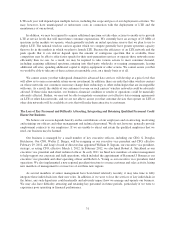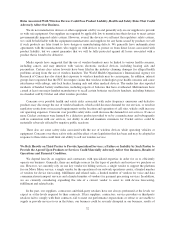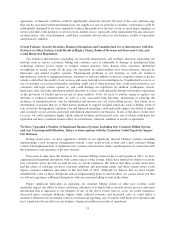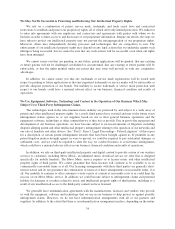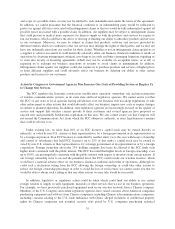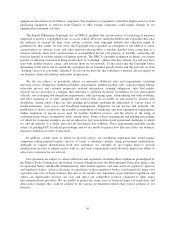Cricket Wireless 2011 Annual Report Download - page 36
Download and view the complete annual report
Please find page 36 of the 2011 Cricket Wireless annual report below. You can navigate through the pages in the report by either clicking on the pages listed below, or by using the keyword search tool below to find specific information within the annual report.terminated for convenience by the controlling member. The FCC’s rules restrict our ability to acquire controlling
membership interests in designated entities during the period that such entities must maintain their eligibility as a
designated entity, as defined by the FCC.
The entities or persons that control Savary Island or any other non-controlled ventures in which we may
invest may have interests and goals that are inconsistent or different from ours which could result in the venture
taking actions that negatively impact our business or financial condition. In addition, if any of the members of
any such ventures files for bankruptcy or otherwise fails to perform its obligations or does not manage the
venture effectively, or if the venture files for bankruptcy, we may lose our equity investment in, and any present
or future opportunity to acquire the assets (including wireless licenses) of, such entity (although a substantial
portion of our investment in Savary Island consists of secured debt).
The FCC has implemented rules and policies to ensure that only legitimate small businesses benefit from the
program, and that such small businesses are not controlled or manipulated by larger wireless carriers or other
investors that do not meet the small business qualification tests. For example, designated entity structures are
subject to a requirement that they seek approval for any event that might affect their ongoing eligibility (for
example, changes in agreements that the FCC has previously reviewed), annual reporting requirements and a
commitment by the FCC to audit each designated entity at least once during the license term. While we believe
that our Savary Island venture is in compliance with these rules, we cannot predict whether and to what extent
the FCC will seek to further modify the designated entity rules. In addition, third parties and the federal
government have in the past challenged certain designated entity structures, alleging violations of federal qui tam
and other laws and seeking significant monetary damages. We cannot predict the degree to which rule changes,
federal court litigation surrounding designated entity structures, increased regulatory scrutiny or third party or
government lawsuits will affect our current or future business ventures, including our arrangements with Savary
Island, or our or Savary Island’s current license holdings or our participation in future FCC spectrum auctions.
Our failure to comply with the FCC’s designated rules could lead to fines or the mandatory restructuring by the
agency of our designated entity venture, and in extreme cases, license revocation, third-party lawsuits and/or
criminal penalties.
We May Have Difficulty Managing and Integrating New Joint Ventures or Partnerships That We Form or
Companies or Businesses That We Acquire.
In addition to growing our business through the operation of our existing and new markets, we may also
expand our business by entering into joint ventures or partnerships with others or acquiring all or portions of
other wireless communications companies or complementary businesses. For example, in October 2010, we and
Pocket contributed substantially all of our respective wireless spectrum and operating assets in the South Texas
region to STX Wireless to create a joint venture to provide Cricket service in the South Texas region, with
Cricket receiving a 75.75% controlling membership interest in the venture and Pocket receiving a 24.25%
non-controlling membership interest.
Entering into joint ventures and partnerships or acquiring other companies or businesses may create
numerous risks and uncertainties, including unanticipated costs and liabilities, possible difficulties associated
with the integration of the parties’ various operations and the potential diversion of management’s time and
attention from our existing operations. In addition, the consolidation of operating assets and operations following
an acquisition or the formation of a joint venture may result in significant costs. For example, during 2011 we
integrated the Cricket and Pocket operating assets in the South Texas region so that the combined network and
retail operations of the STX Wireless joint venture operate more efficiently. During the year ended
December 31, 2011, we incurred approximately $26.4 million of integration charges relating primarily to certain
leased cell site and retail store locations contributed to STX Wireless that it no longer uses, which were recorded
in impairments and other charges within our consolidated statements of operations. As of December 31, 2011,
integration activities were substantially complete and we do not expect to incur additional significant integration
26


